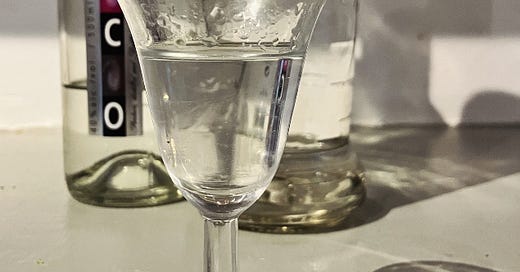~ PISCO ~
Unaged grape brandy from Peru and Chile / 38-48% ABV / c£28+ for 700ml
Friends with: Citrus! And fruits in general, with special mention to passion fruit, grapefruit, apricot, melon, blueberry. Floral liqueurs, especially elderflower and rose; Aperol; sweet white vermouth; eau-de-vie. Cinnamon.
Pisco, as we know, creates the finest sour known to humanity. But what is it? And what else can I make with it? The answer to the second question will arrive in due course. The answer to the first is: it’s a bit like cognac - but far, far superior.
As I await the team of French assassins that this statement will doubtless bring to my door, let me explain. Both spirits are brandies - a brandy being a spirit distilled from fruit, in this case, grapes. Even more specifically, they are both brandies distilled from wine. It is possible to distill brandies from pomace (wine leftovers) but pisco, like cognac and armagnac, is distilled from the good stuff.
Only while these French pretenders acheive their distinct character from ageing in wood, pisco never touches the stuff. It is one of the “secrets” of the distilling trade that just about any high-proof alcohol left in barrels for a long time will end up tasting halfway decent. I remember learning, on my tour of the rum warehouses of Barbados, where wild monkeys danced across teetering skyscrapers of barrels, that many of those barrels contained the remnants of years-old failed rum brands, rums judged drab and mediocre at the time but which would, with ageing, become delicious.
Well, pisco leaves no such room to hide. What you’re tasting when you taste pisco - i.e. sunshine refracted through Andean waterfalls, dew on a desert morning, the shadow of a condor over a dying conquistador, the theme to the greatest children’s TV show of all time - is more or less pisco as it comes, straight from the still. Pisco must taste exquisite in and of itself. Moreover, it cannot be diluted, in the manner of whiskey, rum, etc, but must be bottled as is, between 38 and 48% ABV. What I’m saying is that unlike that trollop cognac, pisco wears no make-up and employs #nofilter and relies instead on her natural beauty.
(Although, pedant’s corner: Peruvian pisco is actually ‘rested’ in neutral vessels; and Chilean pisco is sometimes aged. But you take the point).
Pisco acheives this pulchritude by virtue of sweet grape varietals, derived from the ancient muscat that are ideally suited to the desert-coastal conditions of Peru and Chile. The grapes to look out for in particular are moscatel and torontel which are both have that floral bloom and phantom sweetness that gives pisco its otherworldly loveliness. You might detect a little elderflower, a little orange blossom, the ghost of a peach, the spectre of a cantaloupe and that mysterious violet-lychee maelstrom you find at the centre of Japanese eating grapes before a pleasing keresoney aftertaste. Torontel, incidentally, is a cousin of torrontes, that amazing tropical white grape that thrives in the high-altitude vineyards of northern Argentina and also has a lychee-like tropical quality.
Now I could go into the finer differences between Chilean and Peruvian pisco; but I’d be bluffing and you’d be bored. Needless to say Peruvians consider Peruvian pisco superior and Chileans Chilean; and there are many more national and regional niceties too; Chilean producers tend to prefer column stills and Peruvians pot stills, etc. There are some varieties that taste a little rustic and others that have the pippy-piney qualities of grappa and a handful of aged Chilean piscos too.
But the ones I like best are sweetish, aromatic piscos with lots of fruit and flora and a touch of grit. This is more typical of the Chilean style and Pisco ABA is an outstanding example thereof… relatively affordable too. But Barsol Torontel from Peru is just as lovely (and if you want to explore other varietals, Barsol is go-to producer). Also recommended is Campo de Encanto Acholado, Peruvian, created specifically w/ high-end cocktails in mind.
And now to the recipes.
CABINET POSTS YOU MAY HAVE MISSED
🐿️ Amaretto
🧡 Aperol
🍑 Apricot Brandy
🕊️ Bénédictine
❄️ Brancamenta
🍌 Crème de Banane
🍫 Crème de Cacao
🫐 Crème de Cassis
🌷 Cynar
🏝️ Falernum
🦅 Fernet-Branca
🌿 Green Chartreuse
🐻 Kümmel
🍒 Maraschino
🌵 Mezcal
🐂 Sherry
🌻 Suze
HOW TO MAKE AMAZING COCKTAILS WITH PISCO
Some introductory notes
Keep reading with a 7-day free trial
Subscribe to The Spirits to keep reading this post and get 7 days of free access to the full post archives.




